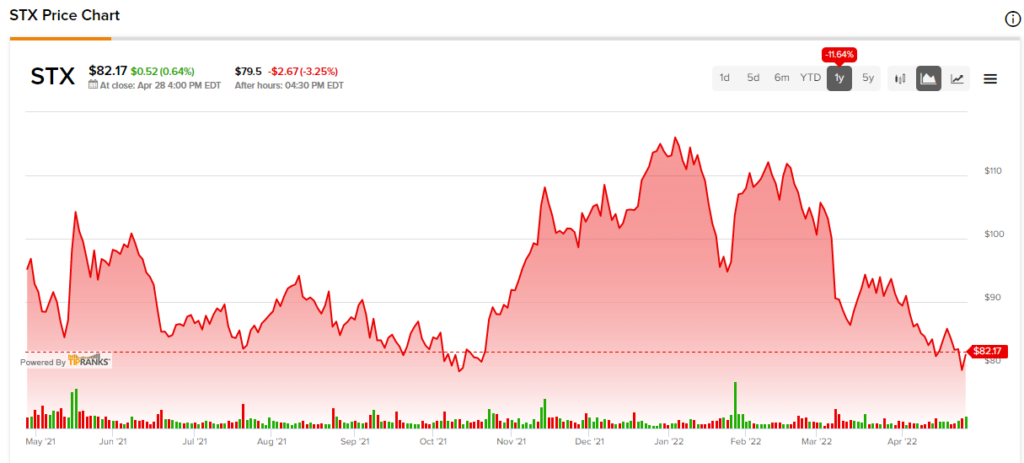Seagate Technology (STX) operates in the expanding data storage industry, though despite an established brand and quality products, growth has stalled over the past decade. With growth prospects looking up and Q3 results just released, this analysis explores the company’s financial performance, shareholder value strategy and valuation.
The Business
Based in Dublin, Seagate Technology offers hardware and software data storage and transfer solutions. The company’s major products include hard drives (HDD, SSHD, and SSD), a systems portfolio that includes storage subsystems for enterprises, cloud service providers, scale-out storage servers, and more. Seagate’s solutions cater to both enterprise and consumer customers.
The global data storage industry offers attractive growth prospects. According to Seagate’s 2021 update of their “Worldwide Global DataSphere Forecast, 2021-2025,” the global “datasphere” should grow from 64 zettabytes in 2020 to 180 zettabytes by 2025, implying strong demand for the company’s storage solutions.
Financial Performance Record & Outlook
Revenue for Seagate has failed to record any meaningful growth over the past decade. A 10-year and 5-year -1.00% and 1.80% CAGR seem disheartening, especially when considering the euphoric macroeconomic environment that led to records in corporate growth over the same time period.
Net income, on the other hand, shows more promise, growing at a 20.57% CAGR over the past 5-years. Operating income has also displayed some growth attributes, recording an 11% CAGR increase since 2017.
After a major retreat in 2020, profitability is recovering, with gross margins reaching for the 30% mark, despite mounting inflationary pressures and global supply chain constraints. Despite broader fluctuation over the last 5 years, net profit margins are currently standing around the 15% level.
On the balance sheet side, Seagate maintains a decent $1.13B cash & equivalents balance, while a 1.5 current ratio should ease any short-term liquidity concerns. One area of possible concern could be an increasing long-term debt balance that is not paired with a proportional sales expansion. Long-term debt/Total Capital stands at 0.92 (or 92%), indicating that leverage is, in fact, somewhat high. Seagate’s long-term debt balance has increased from $4.2B in 2019 to $5.6B as of the last report.
Over the next few years, analysts maintain increased optimism both in terms of revenue and net income growth. A 50% earnings spike is expected for the 2022 fiscal year, while revenue is expected to grow 11% year-over-year. For the next couple of years, growth is expected to moderate, around 10% for net income and 4% for revenue.
Just in: Q3 2022 Results
On April, 27, Seagate reported financial results for Q3 2022, which ended on April 1st, 2022. Quarterly revenue of $2.8B, marked a 2.6% year-over-year increase, while matching analysts’ expectations. Non GAAP EPS of $1.81 missed by $0.07. Cash from operations and Free cash flow came in at $460 million and $363 million. In terms of profitability, the Gross margin rose to 28.8% from 27.1% a year ago (Non-GAAP).
For the upcoming quarter (Q4 2022) management forecasts revenue between $2.65B and $2.95B and Non-GAAP EPS between $1.70 and $2.10. This comes at the low range of previously expected guidance of $2.92.
Consistent with its shareholder value appreciation strategy, the company returned $571 million to investors in the form of dividend payments and share repurchases of 4.1 million shares.
Stock Price Performance
Seagate’s stock price has seen a lot of volatility swings over the past 6-months, or so. After a strong rally in late 2021, causing the stock to reach all-time high levels of $117.67, STX marked a sizable decline at the beginning of 2022, retreating more than 30% to its current price of $82.17. Seagate trades at a $17.35 billion market cap, while paying a 3.41% dividend.

With Shareholder Value in Mind
In today’s market environment Seagate offers an attractive dividend yield of 3.41%, more than double the average S&P 500 yield. However, dividend growth over the past years has been stalling. While the 10-year 17.5% CAGR growth Seagate has recorded is more than sufficient, recently, a slowdown is observable. 5 and 3-year CAGRs of 1.7% and 2.8% appear underwhelming compared to sector medians between 7 -10% and given the concerning increases in inflationary pressures.
On a more positive note, Seagate has a strong, proven record of share repurchases aimed to increase shareholder value over time. Common shares outstanding have decreased from 292 million in 2017 to 220 million today. Especially when considering that the company has been trading at relatively inexpensive valuations, stock buybacks are proven to be an effective way to drive stock returns while at the same time expanding existing shareholders’ stake in the business.
Valuation
By most accounts, Seagate’s current valuation appears attractive. The company trades at a 9.5x FWD P/E ratio and a 1.5x FWD P/S ratio. Both stand below historic averages and sector medians, indicating a possible mispricing by the market. Especially when considering the raised growth and profitability expectations for the company, the value proposition appears appealing. P/FCF of 8.7x and EV/EBITDA of 8.6x also point to similar conclusions.
Wall Street’s Take
Turning to Wall Street, Seagate has a Moderate Buy consensus
rating, based on eight Buys, seven Holds, and one Sell assigned in the last three months. The average STX price target is $96.93, representing a 18.15% upside from current price levels, with a high forecast of $125.00 and a low forecast of $67.00.

Conclusion
After all things are considered, despite an unimpressive past growth performance, raised expectations and attractive valuation multiples make the case for investing in Seagate. A large dividend yield also adds to the stock’s appeal, despite showing rather slow increases over time.
Discover new investment ideas with data you can trust
Read full Disclaimer & Disclosure
















